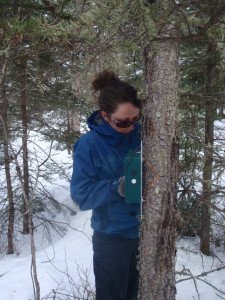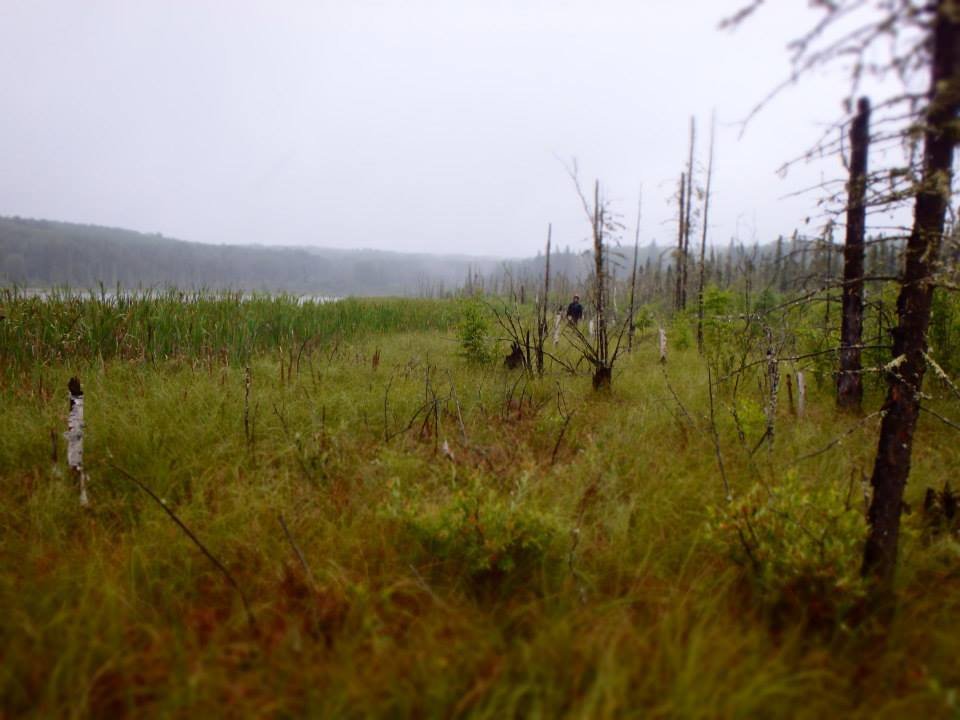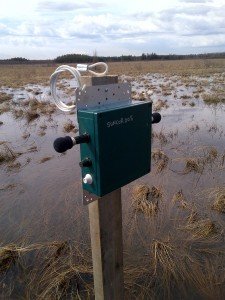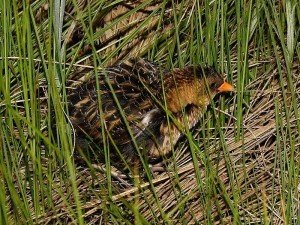Sometimes, monitoring biodiversity is a giant game of hide and seek. Some species are rare. Others are elusive. In both cases, these types of species can be extremely difficult to monitor.
The ABMI’s monitoring system was designed to track changes in groups of common plants and animals, not specifically to follow the status of individual species. This is where the Ecological Monitoring Committee for the Lower Athabasca (EMCLA) comes in.

EMCLA Technician Michelle Knaggs braves wintery conditions to deploy automated recording units (ARUs) for owl surveys. Photo: Julia Shonfield
The EMCLA, a consortium of oil sands companies, government ministries and agencies coordinated by the ABMI, was established in 2010 with the goal of designing protocols to monitor rare and elusive species.
In the case of rare animals, where individuals can move or hide, the EMCLA is testing new technology to enhance our ability to detect these creatures. Over the past 2 years, it has piloted the use of automated recording units (ARUs) to monitor rare vocalizing species, or species that make sounds, with a focus on owls, amphibians, and the seldom seen Yellow Rail.
The Yellow Rail is a small, secretive marsh bird that is primarily active at night. Little is known about these birds – they’re hard to find! – but, they’ve been reported in marshes and wet meadows in both prairie and forested habitats. The Yellow Rail is a species of Special Concern in Canada and a monitoring priority for the EMCLA. Since ARU’s can be installed just about anywhere and programmed to record at any predetermined time, they are ideal for tracking species like the Yellow Rail.
Although technology can improve our ability to monitor rare animals, the work, nonetheless, is often incredibly challenging. The project relies on a hard-working, dedicated team, willing to push boundaries in pursuit of these mysterious critters.
To begin, the field season is long: this year it went from March until August. The range of species targeted by the EMCLA demands an extended field season – owl surveys are conducted in late winter, amphibians are most active in early spring, and the optimal time to detect the Yellow Rail is early summer.
Accessing field sites for these difficult-to-monitor species also presents a range of obstacles. “Exploring and navigating sites rarely visited by humans is a challenging, albeit, memorable experience,” says Alex Macphail, a lead technician for the EMCLA. Various modes of transportation, from snowshoes to quads and helicopters, are necessary to traverse snow-covered landscapes for the owl surveys and waterlogged bogs and fens for the amphibian and Yellow Rail work, respectively, adds Alex.
Difficult field conditions often present additional logistical challenges that are hard to foresee, such as: bringing in a ladder to rescue an ARU installed in winter on a tree from the top of a tall snow bank, but stranded in mid-air after the snow melt; or, drying off after navigating dense fen wetlands, falling through and receiving a thorough soaking!
For Alex, however, the payoff was personally experiencing these elusive species. “The most interesting thing that happened was getting close to rare species, like the Yellow Rail, for the first time. It was truly exciting!”
The team had many successes, including collecting a tremendous amount of data and improving our ability to target and identify Yellow Rail habitat. The work doesn’t end here though – for the next few months, the team will be busy processing and identifying all the species on the ARU recordings. No doubt, they’re up to the challenge!
Top Photo: Michelle Knaggs



